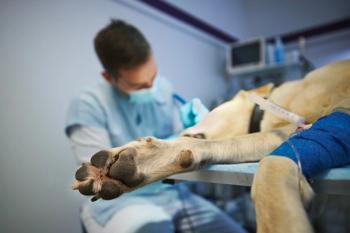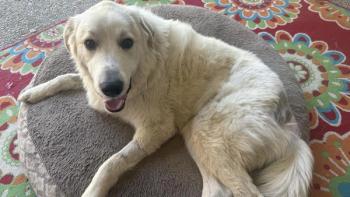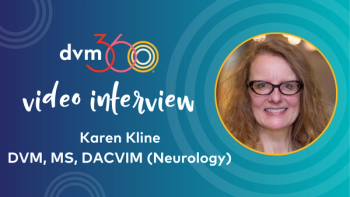
Cranial nerve testing (Proceedings)
The neurological examination is the most important tool for localizing vestibular signs to either the peripheral or central areas.
Summary of Cranial nerve functions
CN I-olfactory-Smell
CN II-optic-Vision and pupillary light reflexes
CN III-oculomotor-1) Medial (primarily) movement of the eye through innervation of the extaocular muscles, 2) Pupillary constriction through parasympathetic innervation of the iris
CN IV-trochlear: Extorion of the eye through innervation of the dorsal oblique extraocular muscle
CN V-trigeminal-1) Sensation to the eye and cornea 2) Sensation to the maxillary area, 3) Motor innervation to the muscle of mastication
CN VI-abducens-Innervation to the lateral rectus and retractor bulbi extraocular muscles
CN VII-facial-1) Motor to the muscles of facial expression, 2) Taste, 3) Salivation/lacrimation, 4) Skin sensation (ear)
CN VII-vestibulocochlear-1) Balance and posture 2) Hearing
CN IX-glossopharyngeal-1) Motor and sensation to pharynx, 2) Taste, 3) Salivation
CN X-vagus-1) Motor and sensation to larynx, 2) Taste, 3) Salivation, 4) Parasympathetic innervation to viscera
CN XI-accessory-Motor to trapezius muscle
CN XII-hypoglossal-Motor to the tongue
CN Testing
CN 1: Olfactory N: Not routinely tested.
CN 2: Optic N: Observing movement of the animal in the room and assessing its ability to follow objects evaluate vision. If in doubt, throw a cotton ball in the animal's visual field and see if he follows it with his eyes. Making a menacing gesture towards the animal's eye performs the menace response; look for a blink. Pupillary light reflexes are evaluated with a bright light and looking for both direct and consensual responses.
CN 3: Oculomotor N: The parasympathetic component of CN III is evaluated with pupillary light reflexes. CN III dysfunction causes a ventrolateral strabismus due to paralysis of the majority of the extraocular muscles; ptosis due to paralysis of the levator palpebrae muscle; mydriasis and unresponsive pupil due to paralysis of the iris muscle, and reduced or asymmetrical eyeball movements when testing physiological nystagmus in vertical and horizontal planes.
CN 4: Trochlear N: CN IV dysfunction causes lateral deviation of the superior retinal vein on ophthalmoscopic exam in the dog (round pupil), and lateral deviation of the dorsal aspect of the pupil in the cat (vertical pupil).
CN 3, 4, and 6: They are usually evaluated together by observing eye movement in all planes. CN 6: Abducens N: CN VI dysfunction causes medial strabismus of the eyeball and reduced or symmetrical movements of the eyeball when testing physiological nystagmus in the horizontal plane. Note that it can be tested with the "Corneal reflex" described under CN 5.
CN 5 and 7 are usually evaluated together. CN 5 supplies sensation to the face while CN 7 is motor to muscles of facial expression. Gently touch, pinch, or stroke the hairs of the face and see if the animal responds with facial movement, eye blink, lip retraction, etc.
CN 6: Trigeminal N
1. Anatomy
a. Motor (efferent) = mandibular branch innervates the muscles of mastication (temporalis, masseter, medial and lateral pterygoid, rostral digastricus and mylohyoid muscles).
b. Sensory (afferent) = ophthalmic, maxillary and mandibular branches are responsible for nociception and proprioception to most parts of the head (face, eyelids, pinnae, cornea, oral cavity and mucosa of the nasal septum).
2. Sensory Testing
a. Nasal mucosa: Touch nasal mucosa on the medial nasal septum. If sensory portion is intact and if animal has normal mentation, the animal's head will retract (cortical response).
b. Corneal reflex: Touch center of cornea (autonomous zone of the ophthalmic branch) with a moist cotton swab; observe for retraction of globe eye blink CN V afferent (ophthalmic branch only), CN VI (retraction) VII (blink) efferent
c. Palpebral reflex: Touch medial canthus of eye; observe for eye blink. CN V afferent (ophthalmic and maxillary branches), CN VII efferent
d. Trigeminofacial reflex: Touch area of maxillary vibrissae, observe for eye blink. CN V afferent, CN VII efferent
3. Motor testing: Look for atrophy of muscles of mastication, inability to close mouth.
4. Signs of Motor Dysfunction: Atrophy of temporalis or massetter muscles; inability to close mouth.
5. Signs of Sensory Dysfunction: Corneal ulcer; rubbing or pawing at face
CN 7: Facial N
1. Anatomy: The nucleus of the facial nerve is located in the rostral medulla. Axons exit the brain stem, course with cranial nerve VIII through the internal acoustic meatus of the petrous bone, travel near the middle ear, exit the skull at the stylomastoid foramen, and finally course around the ramus of the mandible. The facial nerve has several branches: 1) buccal branches innervate muscles of the cheek and lips. 2) Auriculopalpebral branch divides into the auricular and palpebral branches to innervate the ear and eyelid muscles, respectively.
2. Motor to the muscles of facial expression: muscles of eyelids, lips, ears, nose. It also innervates the cheek and the caudal portion of the digastricus muscle.
3.Sensory to the concave surfaces of the pinnae and the rostral part of the tongue
4. Parasympathetic secretory fibers to the salivary and lacrimal glands and to the mucous membranes of the oral and nasal cavities.
5. Sensory Testing: Not routinely done.
6. Motor Testing: see Corneal, Palpebral, and Trigeminofacial reflexes described with CN 5. You can also pinch the upper lip with hemostats.
7.Signs of Sensory Dysfunction: Taste issues not routinely seen or evaluated for.
8. Signs of Motor Dysfunction: Inability to close eye, move upper lip, or move ear. Because the upper lip lacks muscle tone, the affected patient cannot keep saliva, water, or food completely in its mouth so there may be excessive drooling on affected side.
9.Signs of Parasympathetic Dysfunction: Dry eye; reduced Schrimer Tear Test
CN 8: Vestibulo-cochlear N
CLINICAL SIGNS OF UNILATERAL VESTIBULAR PROBLEM: these signs are common to both central and peripheral lesions:
Head tilt toward the affected side Asymmetrical ataxia Nystagmus with the fast phase away from the affected side Strabismus on affected side Falling and rolling toward affected side Ventrolateral strabismus (extend the head and look for an eye drop on the affected side) Decreased ability to right itself Systemic signs: nausea, vomiting, and anorexia.
PERIPHERAL VS. CENTRAL VESTIBULAR DISEASE
Peripheral vestibular: Inner ear or CN VIII.
Central vestibular: Brain stem i.e. the vestibular nuclei and tracts located in the brain stem or the vestibular parts of the cerebellum).
Important points: 1. The neurological examination is the most important tool for localizing vestibular signs to either the peripheral or central areas. 2. The rule outs are different for the 2 different locations of vestibular signs. 3. The prognosis is different: Central vestibular disease has a more guarded prognosis than does peripheral vestibular disease.
How to Tell Difference Between Central and Peripheral Vestibular Signs
With central vestibular disease there will be involvement of the motor tracts of the brain stem causing ipsilateral hemiparesis, generalized weakness, and/or proprioception deficits. Lesions affecting the vestibulocerebellar pathways can result in hypermetria on the affected side, head bobbing, tremors, and head tilt. Depressed mental status may be present too because of involvement of the reticular activating system in the brain stem. Central signs also often include vertical nystagmus or nystagmus that can only be elicited if the head is put into different positions. A good way to look for positional nystagmus is to put the animal into lateral recumbency and extend the head rapidly and then quickly turn the animal onto its dorsum, looking at the eyes all the time.
Paradoxical Vestibular Signs
Paradoxical vestibular syndrome is an interesting condition in which the head tilt is not to the affected side but away from the affected side. Paradoxical vestibular signs are always associated with central vestibular lesions, usually located in the cerebello-vestibular area, specifically the cerebellar peduncles, cerebellar medulla, or flocculonodular lobe of cerebellum. One clue that this syndrome is present is finding conscious proprioception deficits on the side opposite the head tilt. The lesion location should be presumed to be on the side with the proprioceptive deficits. Other vestibulo-cerebellar signs are usually present too such as head bobs, intention tremors and hypermetria. The most common causes are mass lesions such as neoplasia or focal granulomatous meningoencephalitis although other causes are possible (trauma, abscess, or extension of otitis interna to the cerebellar area).
Bilateral Vestibular Signs
Occasionally peripheral vestibular disease is bilateral making the signs more difficult to localize since a head tilt and nystagmus are usually absent in such cases. Affected cases have an ataxic gait, wide swinging head motions usually from side to side, and lack of the oculocephalic reflex (eyes do not track with the head movement as examiner turns animal's head from side to side). Bilateral vestibular signs may not improve with time. Causes include idiopathic vestibular syndrome, ototoxins, trauma, and ear infections (especially ear mites).
Causes of Peripheral Vestibular Signs
Otitis interna, hypothyroidism, Idiopathic Vestibular Disease, Neoplasia, Congenital vestibular syndrome, and rickettsial (Rocky Mountain spotted fever or ehrlichiosis) diseases.
Causes of Central Vestibular Signs
Neoplasia, granulomatous meningoencephalitis, hypothyroidism, rickettsial vasculitis, canine distemper, protozoal infections, fungal infections, extension of bacterial otitis interna to brain stem, and toxins, most notably metronidazole. The diagnosis of central vestibular masses and infections often relies upon brain scans, serum titers, and spinal fluid analysis.
CN 9, 10, 11: While these cranial nerves have a variety of functions, normally we only test pharyngeal sensation and motor function with a gag response. Taste is only rarely evaluated. If the animal is bradycardic due to vagal hypertonus, pressing on the globe may increase heart rate.
CN 12: Hypoglossal: Tongue movement is used to evaluate CN XII function. Unilateral lesions may be visualized as "wrinkling" of tongue on affected side.
Newsletter
From exam room tips to practice management insights, get trusted veterinary news delivered straight to your inbox—subscribe to dvm360.






